Avoid a Failed Inventory Management Software Implementation by Learning From Buyers With Experience
Inventory management software is crucial for handling your shipping and logistics requirements. Not only does the software increase the efficiency of order processing, inventory tracking, and reordering, but it also helps reduce human processing errors associated with inventory management.
However, finding the right software requires knowing your unique requirements, understanding what budget to set, and discovering the most sought-after features in any software.
Each year, Software Advice's advisors speak with thousands of software purchase decision-makers evaluating new inventory management software for their businesses. We've mined those conversations for insights on other small businesses' budgets, feature needs, and pain points to aid your software search.
Key insights
Software buyers from the inventory management industry prioritize reporting and analytics during purchase, while actual users consider inventory control feature the top priority in inventory management software.
Most businesses rely on manual methods, spreadsheets, or third-party software for their day-to-day inventory management operations, such as inventory tracking and goods distribution.
Switching to inventory management software is driven by inefficiency, limited functionality, and unreliability in current methods and software.
The top five industries investing in inventory management software allocate $129-$165 per user per month, with an overall buyer average of $142 per user per month.
Buyers seek reporting and analytics, while users rate inventory control as a critical feature
To gain insights into user preferences, we analyzed thousands of inventory management software reviews available on Software Advice to identify the features that inventory management software users consider the most critical for their daily work. Interestingly, our findings revealed a discrepancy between the priorities of inventory management software buyers and users.
Forty-three percent of actual inventory management software users rate inventory control as a critical feature. On the other hand, 92% of inventory management software buyers prioritize the reporting and analytics feature during software purchase.
These findings indicate that businesses already using inventory management software find immense value in inventory control as it helps prevent overstocking and understocking of goods, reduces holding costs by maintaining optimal stock levels, and eliminates human errors in data entry in inventory records.
On the other hand, buyers seeking inventory management software focus more on the reporting and analytics features during software selection. Reporting and analytics offer real-time visibility into inventory levels, allowing businesses to monitor stock levels and track changes as they happen. Additionally, the feature helps analyze past sales data and trends, to predict future demand more accurately. This helps in optimizing stock levels and preventing excess inventory or stockouts.
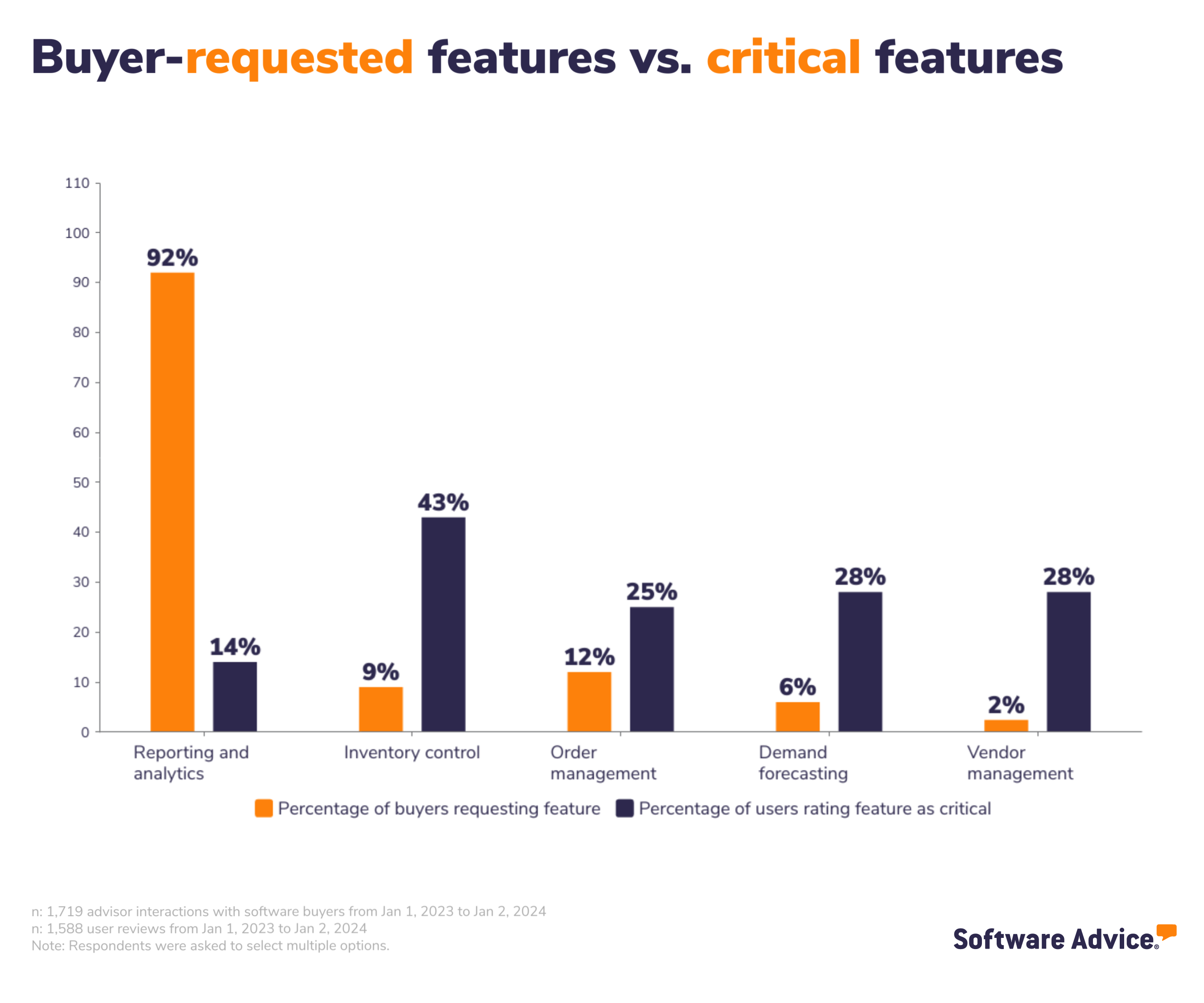
Pro tip
Understand the nature of your inventory, including the types of products, perishability, and any unique characteristics. Also, identify industry-specific requirements and compliance standards that the software must meet (e.g., regulatory requirements for healthcare or food safety standards for the food and beverage industry).
Most businesses rely on manual methods, spreadsheets, and third-party software for their day-to-day inventory management operations
When our advisors asked buyers what methods they were currently using to handle their day-to-day inventory management operations, here's what they found:
Forty-one percent of buyers use manual methods to log their inventory holding and keep track of what they have in stock.
Twenty-six percent of buyers use spreadsheets to keep track of inventory and manage data sets related to storage and shipping.
While such methods can help manage day-to-day operations, having a dedicated inventory management platform is crucial to centralize routine tasks, such as order processing and goods tracking, freeing up time for employees to focus on more strategic and value-adding activities. Inventory management software also maintains accurate records for regulatory compliance and generates detailed reports, ensuring that businesses adhere to industry standards and regulations.
Clubbing all required functionality within a single inventory management system eliminates the need to invest in multiple third-party software and manage their licenses, subscriptions, and integrations.
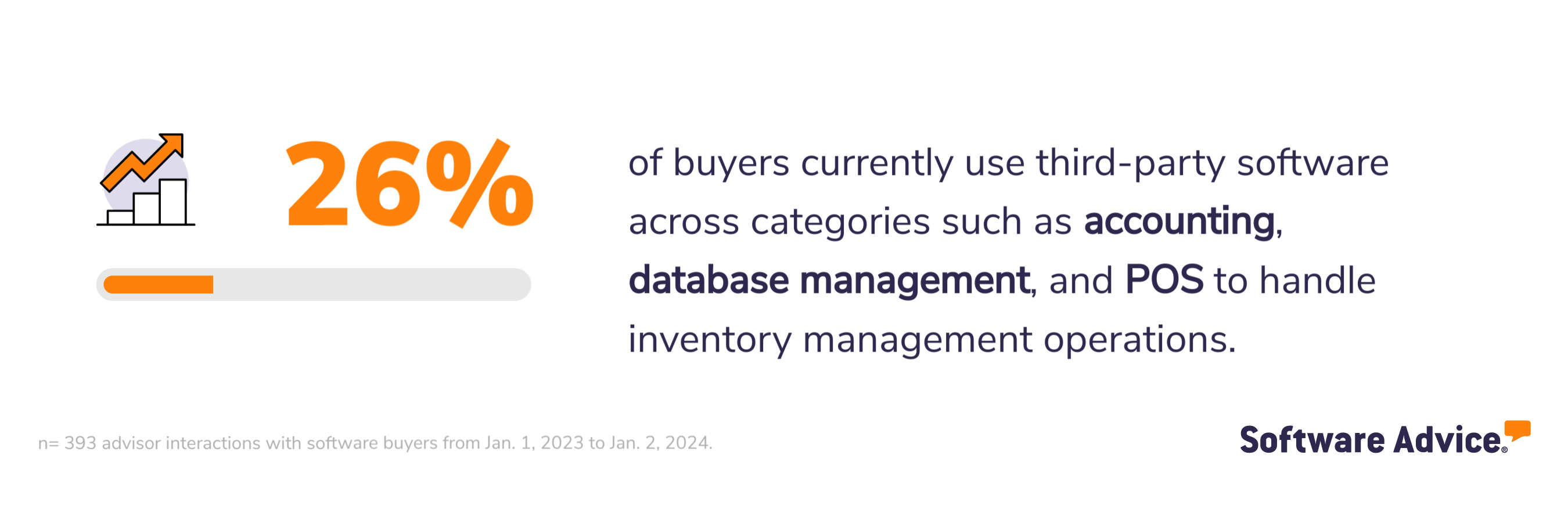
Pro tip
Ensure that the inventory management software can seamlessly integrate with other critical systems that your organization may be using, such as accounting software, e-commerce platforms, or ERP systems.
Inefficiency, limited functionality, and unreliability are key drivers of inventory management software switch
Our advisors conversed with buyers currently using either manual methods or third-party software and seeking a switch to inventory management software. These discussions shed light on businesses' real-life challenges with their existing tools. These included inefficiency (51%), limited functionality (31%), and unreliability (7%).
Inefficiency: Third-party tools often rely heavily on manual data entry, order processing, and tracking, which can lead to inefficiencies and errors. Additionally, lagging or slow software performance can hinder productivity and cause delays in critical processes.
Limited functionality: If the current software lacks essential features needed for efficient inventory management, businesses may find themselves constrained in their operations. Similarly, third-party software that cannot scale to accommodate growing inventory needs or changing business requirements may limit future expansion.
Unreliability: Regular system outages or downtime can disrupt operations, leading to delays in order processing and negatively impacting customer satisfaction. If the current software consistently produces inaccurate inventory data, it can result in mismanagement of stock levels and poor decision-making.
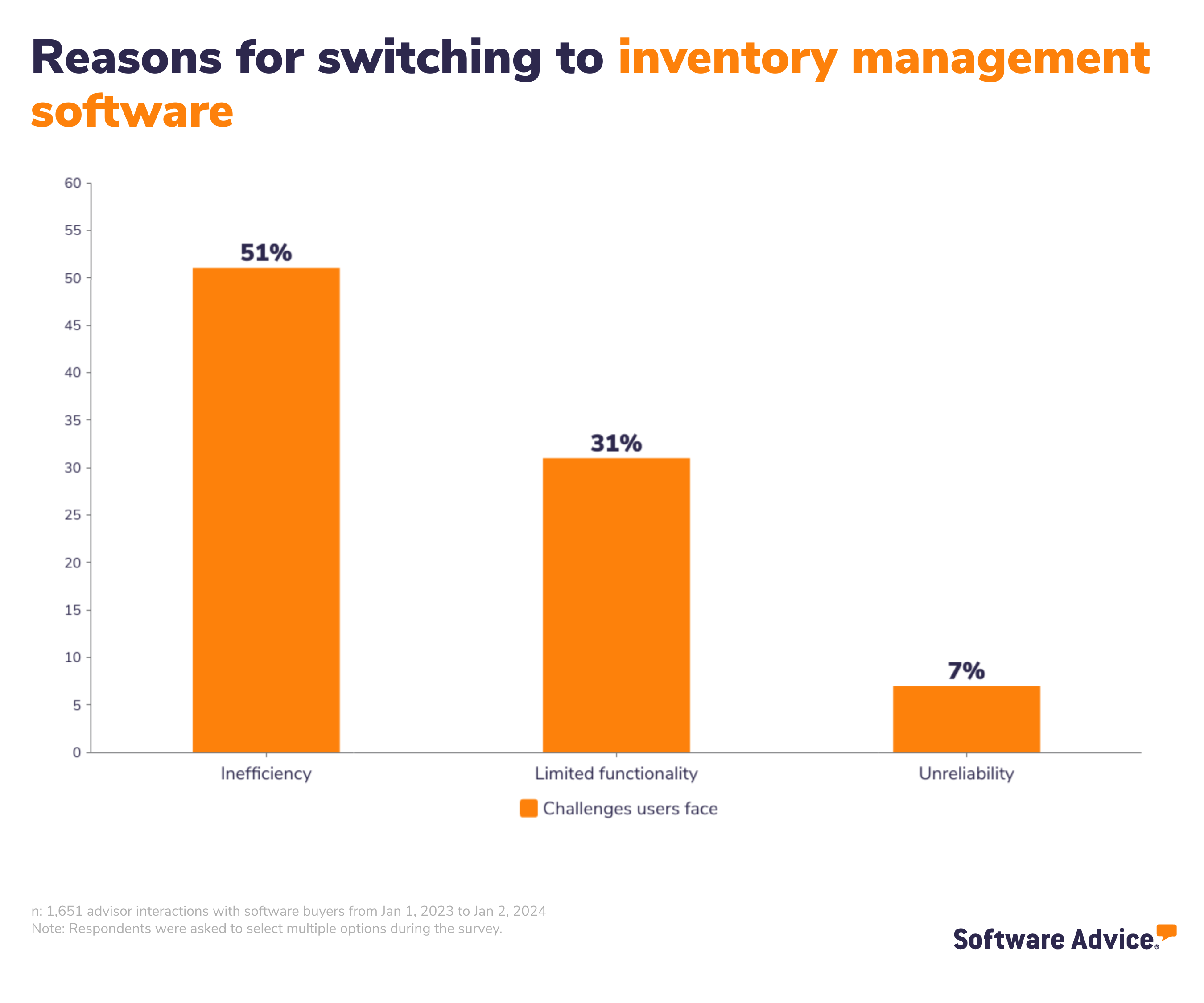
Pro tip
Look for features that automate routine tasks, such as order processing, reordering, and data entry, to improve efficiency and reduce the risk of human errors. Such automation also helps businesses comply with industry regulations and standards. This is particularly important for traceability, product recalls, and maintaining proper documentation.
Use cases for inventory management software
Construction and engineering businesses utilize inventory management software to efficiently manage and control the flow of materials, tools, and equipment throughout various construction projects. Inventory management software provides real-time visibility into material quantities, locations, and usage.
Retailers can use inventory management software to monitor stock levels in real time, minimizing the risk of stockouts and ensuring that products are consistently available for customers. By analyzing sales trends and historical data, retailers can optimize stock levels to avoid overstocking, which helps reduce holding costs and the risk of product obsolescence.
Healthcare facilities use inventory management to track and manage medical supplies, ensuring that essential items are available when needed. The software also helps pharmacies and healthcare institutions comply with strict regulatory requirements for pharmaceutical inventory management.
Pro tip
Prioritize software that offers customization in terms of inventory tracking. For instance, If you are a food and beverage business, the software should let you track traceability for perishable goods and temperature and humidity monitoring. Alternatively, if you have an automotive business, it should help you keep track of serial numbers for auto parts.
The average buyer’s budget ranges from $129 to $165 per user, per month
The budget for purchasing inventory management software varies from industry to industry based on factors such as organization size, the number of users, and the required features and functionalities.
However, the average budget across industries for purchasing inventory management software was approximately $142 per user per month.
The chart below highlights the average buyer budget per user, per month for the top five industries that use inventory management software.

More resources for your software search
Whether you’re looking to buy new inventory management software or replace your existing tool, here are some additional resources to aid your software search:
Start with our interactive inventory management software directory to compare hundreds of products, filter your search by specific features, and read comprehensive reviews from SMB leaders.
Check out top-rated inventory management software based on user ratings and popularity in the 2024 Inventory Management Frontrunners Report.
Review inventory management software buyers guide to better understand the market.
Buyer demographics
The buyers we interacted with are largely small businesses. You’ll find the demographics of the buyers below, so you can see the sizes and types of businesses, from annual revenue to industry.
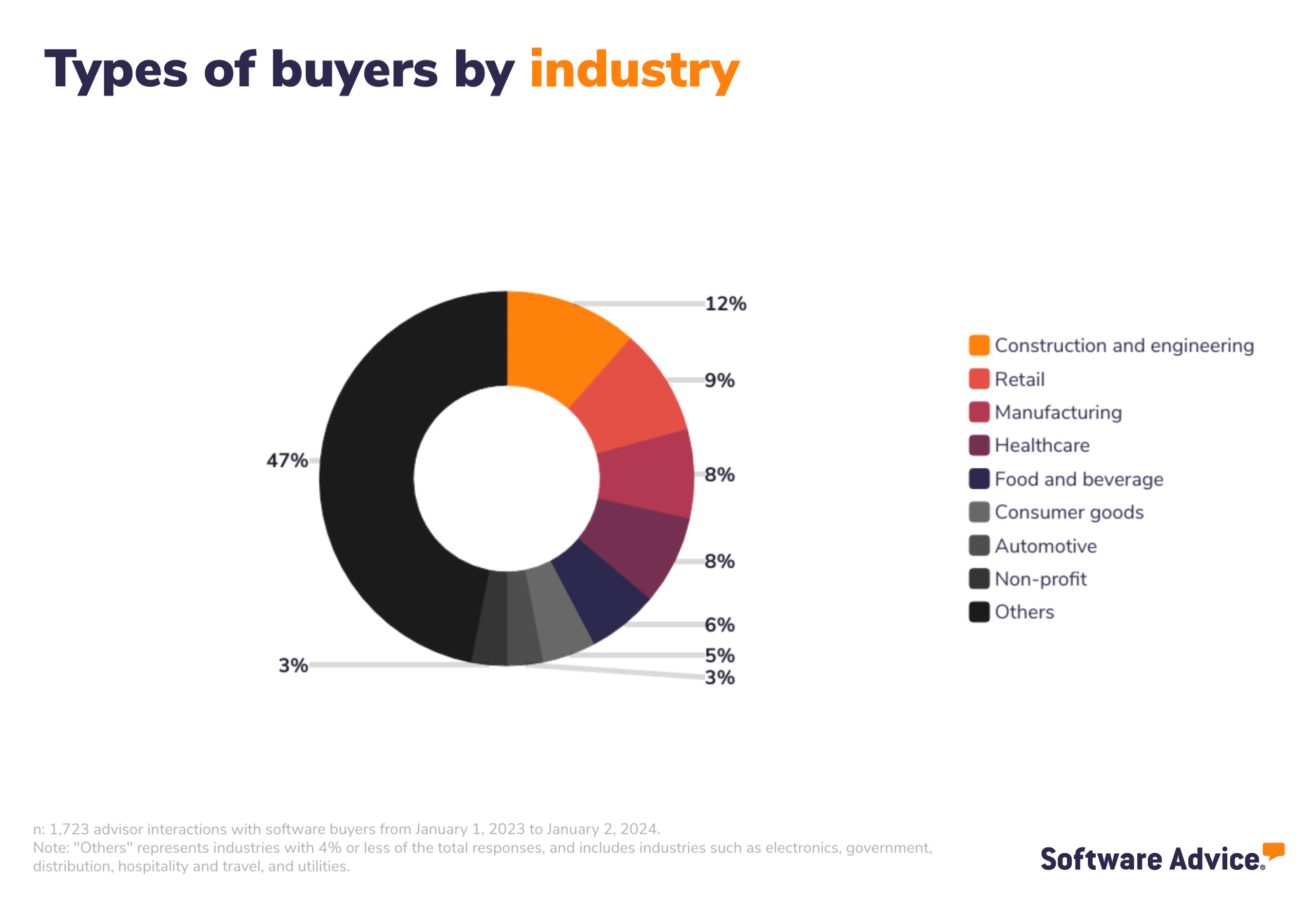
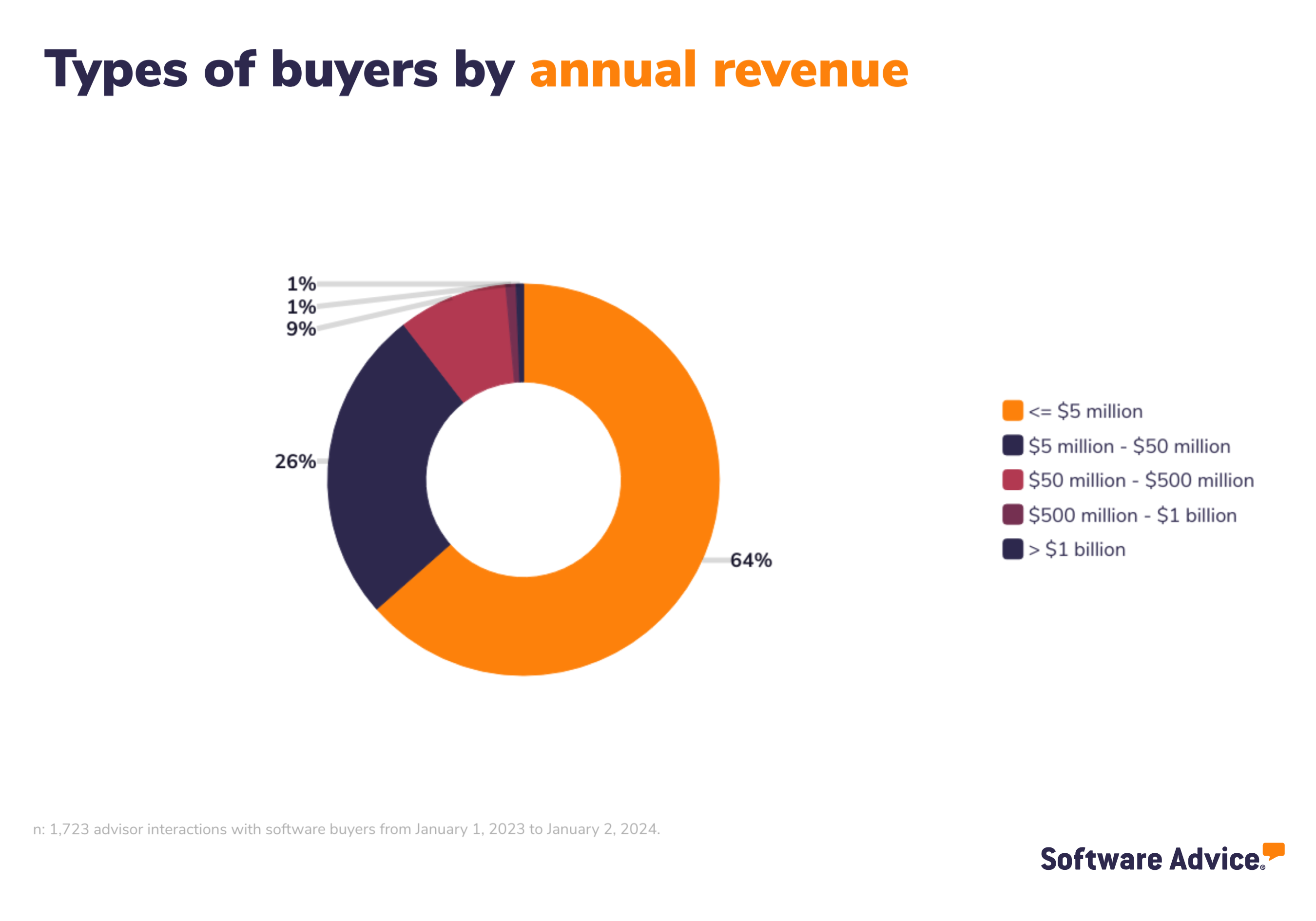
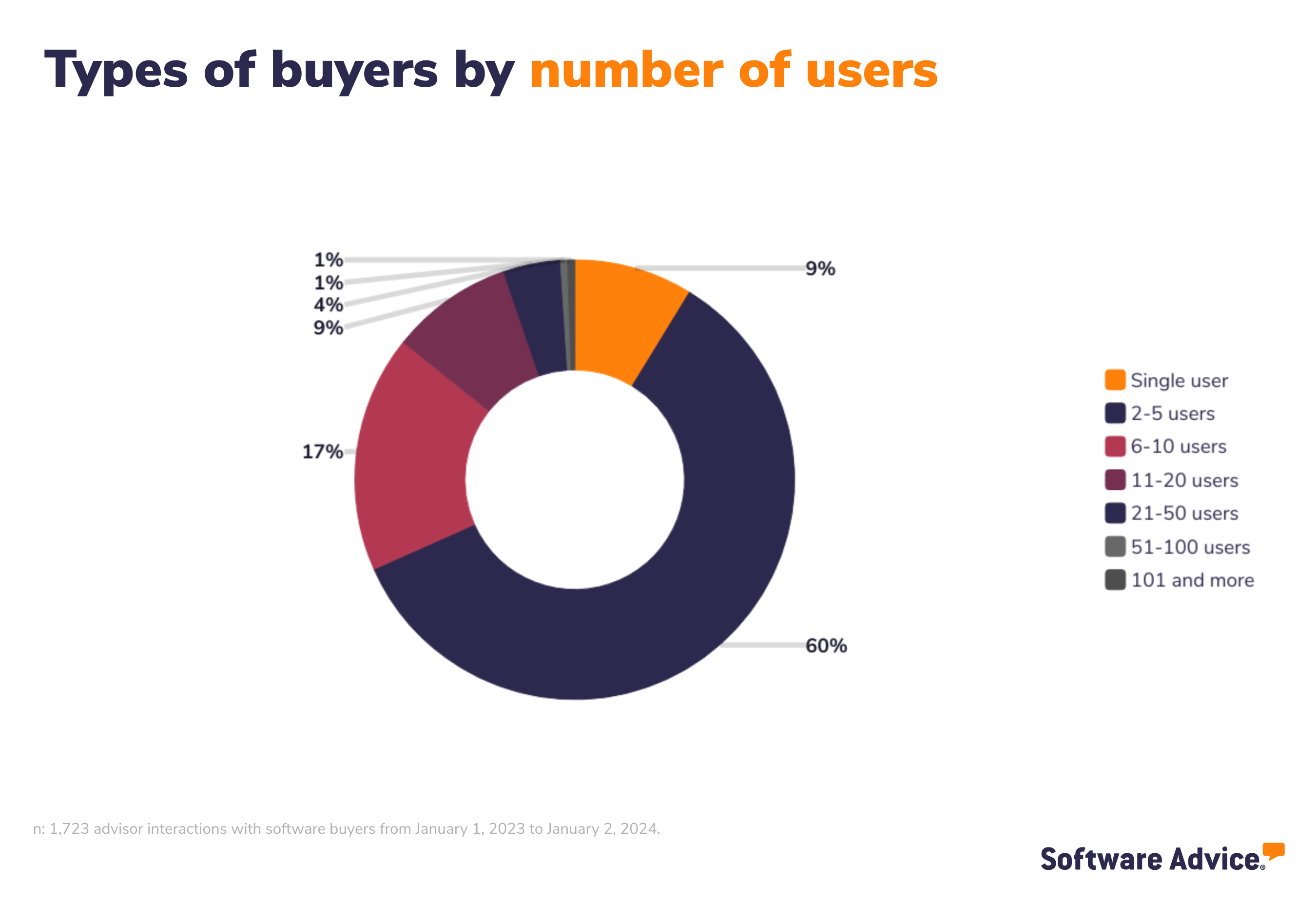
Methodology
Software buyers analysis methodology
Findings are based on data from conversations that Software Advice’s advisor team has daily with software buyers seeking guidance on purchase decisions. The data used to create this report is based on interactions with small-to-midsize businesses seeking inventory management tools. For this report, we analyzed approximately 1,723 phone interactions from Jan 1, 2023, to Jan 2, 2024.
The findings of this report represent buyers who contacted Software Advice and may not be indicative of the market as a whole. Data points are rounded to the nearest whole number.